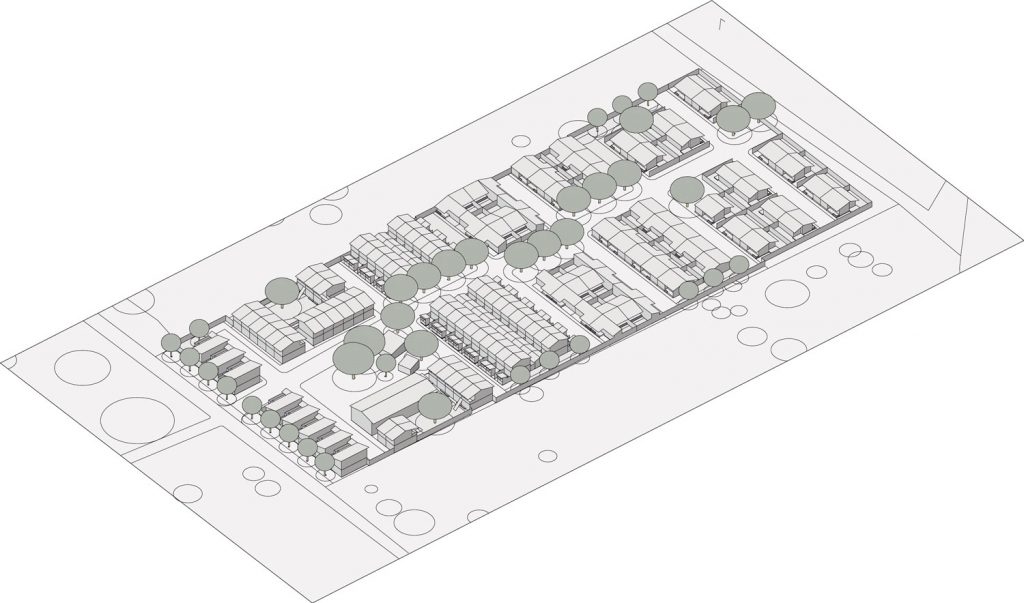
Beira Affordable Housing Project was developed in 2017 in collaboration with Reall in relation to their pilot project in Beira for their Mozambican affordable housing program. The project proposes a dense settlement structure, with numerous public spaces, active social zones adjacent to the streets, small plot sizes, and houses that share walls and installations with neighbors to minimize costs. The project proposes six different housing typologies of various sizes in one or two stories.
The project contains an underlying criticism of the conventional Mozambican planning models and housing typologies. The low-dense suburban detached housing units with car-based urban design that characterize the contemporary Mozambican architecture and planning discourse, seem both inappropriate and unreasonable considering the limited resources that are available. This project seeks to uncover alternative paths to improve the living conditions through a more humble approach to resource consumption and the amount of land we occupy when we build with a special attention to the inherrent qualities of the context and the common space.
The site is located in an area approximately 1 km from E6, which is the main road connecting Beira to the rest of the country and Zimbabwe. Accordingly, options for public transport are disirable. There are local job opportunities, as industries are growing in the area. Informal settlements are growing in the area to provide housing for the workforce for the industries.
The site has approximate dimensions of 225m x 83m, 1,8 Ha. The local area is characterized by agriculture. The neighboring site seems to be in preparation for large scale construction, as it has piles of gravel on site and a wall constructed towards the road. There are some large trees on the site which should be considered as qualities of the site, efforts to presserve these should be a priority of any eventual plan. There are two minor built structures on site, which could be preserved to link the future development of the site with it’s past. The local main road is only 5m wide and space for expanding it should be allocated.
The main spatial concept of the plan revolves around a main street connecting to the local main road, and secondary side streets providing access to the plots. This concept is allows the most efficient use of the space on the site. Varying distances between the ssecondary streets allows different plot sizes, enabling a variety of different housing typologies. The plan is robust, in the sence, that should other housing typologies than the proposed be disired, the distances between the side streets can easily be modified to allow different plot sizes, without compromizing the bearing idea of the plan. Should the neighboring sites be developed it will be simple to connect the street network of the site to these. The plan proposes a main public space, close to the main entrance of the site where all residents pass through, promoting social intereactions. The public space is located where there are several old trees on the site today providing shade for eventual social life. A civic center, containing a church/community center, a Reall office and small shops is proposed adjacent the main public space. Secondary public spaces are proposed along the main street, as well as in the site periphery, allowing pedestrian short cuts. The secondary public spaces are proposed programmed for, car parking, soccer and communal gardens with vegetables, mango and papaya trees. The six different housing typologies are distributed as clusters of the same typologies in each space between the secondary streets. There are three different two-story housing typologies and three different single story typologies. The two-story typologies are located closest to the local main road to create a more urban and dense condition around the main public space, which both creates a physical frame defining the space and locates more people in the area securing more active social life. There are 16 single room housing units, 52 double room housing units, 43 three room housing units, 45 four room housing units. A total of 156 housing units. The 45 single story four room housing units can be expanded gradually. The smaller housing types in the two-story buildings are fixed in size, but offers both, single room, double room and tripple room housing types. Should a family or resident living in one of these desire more space, internal movement to another home within the community would be the solution.